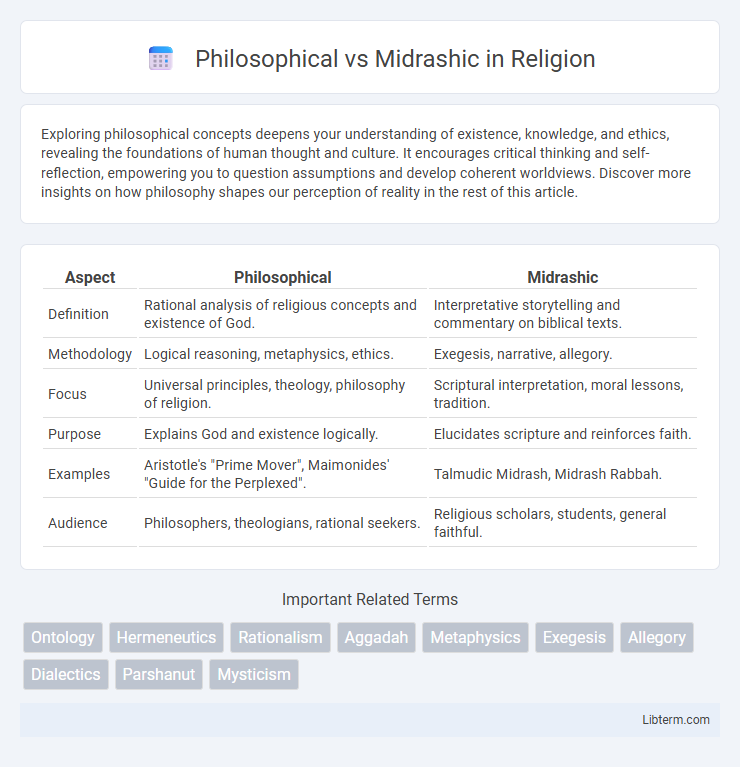Exploring philosophical concepts deepens your understanding of existence, knowledge, and ethics, revealing the foundations of human thought and culture. It encourages critical thinking and self-reflection, empowering you to question assumptions and develop coherent worldviews. Discover more insights on how philosophy shapes our perception of reality in the rest of this article.
Table of Comparison
| Aspect | Philosophical | Midrashic |
|---|---|---|
| Definition | Rational analysis of religious concepts and existence of God. | Interpretative storytelling and commentary on biblical texts. |
| Methodology | Logical reasoning, metaphysics, ethics. | Exegesis, narrative, allegory. |
| Focus | Universal principles, theology, philosophy of religion. | Scriptural interpretation, moral lessons, tradition. |
| Purpose | Explains God and existence logically. | Elucidates scripture and reinforces faith. |
| Examples | Aristotle's "Prime Mover", Maimonides' "Guide for the Perplexed". | Talmudic Midrash, Midrash Rabbah. |
| Audience | Philosophers, theologians, rational seekers. | Religious scholars, students, general faithful. |
Defining Philosophical and Midrashic Approaches
Philosophical approaches emphasize rational analysis and systematic reasoning to explore fundamental questions about existence, ethics, and knowledge, often drawing on classical logic and metaphysics. Midrashic approaches prioritize interpretive narratives and exegetical methods rooted in Jewish scriptural tradition, aiming to uncover layered meanings and moral lessons within biblical texts. Both methodologies offer distinct frameworks: philosophical inquiry seeks universal principles through abstract thought, while midrashic study illuminates cultural and theological insights through storytelling and textual expansion.
Historical Origins and Development
Philosophical interpretations trace back to ancient Greek and Hellenistic thinkers, emphasizing rational inquiry and metaphysical concepts, influencing Jewish thought through figures like Philo of Alexandria and Maimonides. Midrashic approaches originated in the early Rabbinic period, around 2nd century CE, focusing on scriptural exegesis and oral traditions to elucidate biblical texts within the Talmudic framework. The development of Midrashic literature paralleled the formalization of Jewish law, while philosophical theology incorporated external philosophical methodologies, shaping distinct but interrelated interpretative traditions.
Key Figures and Texts
Philosophical approaches to Jewish thought often center on key figures such as Maimonides, whose seminal work, "The Guide for the Perplexed," integrates Aristotelian philosophy with Jewish theology, emphasizing rational inquiry. Midrashic tradition highlights rabbis like Rabbi Akiva and Rav Huna, whose interpretative methods in texts like "Midrash Rabbah" and "Sifra" employ homiletic and allegorical techniques to elucidate biblical narratives. The contrast between these approaches lies in the philosophical texts' focus on metaphysical concepts and the Midrashic texts' emphasis on narrative expansion and legal exegesis.
Methodologies of Interpretation
Philosophical interpretation emphasizes rational analysis and logical coherence to uncover universal truths and ethical principles, relying on critical reasoning and systematic argumentation. Midrashic interpretation employs narrative expansion, allegory, and textual juxtaposition to reveal deeper spiritual and moral meanings within biblical texts, often addressing ambiguities and exploring multiple layers of meaning. These methodologies contrast in their approach: philosophical exegesis seeks abstract, conceptual clarity, while Midrashic exegesis focuses on contextual and imaginative elaboration of scriptural stories.
Philosophical Reasoning vs. Narrative Expansion
Philosophical reasoning emphasizes logical analysis and abstract concepts to explore fundamental questions about existence, knowledge, and ethics. Midrashic narrative expansion enriches biblical texts by adding imaginative stories and interpretations that reveal deeper moral and spiritual meanings. While philosophical thought seeks universal truths through critical inquiry, midrashic tradition prioritizes contextual storytelling to connect scripture with lived experience.
Purpose and Aims of Each Approach
Philosophical interpretation seeks to uncover universal truths and ethical principles through rational analysis and logical argumentation, aiming to develop coherent worldviews and address existential questions. Midrashic interpretation focuses on elucidating sacred texts by exploring narrative details, moral lessons, and divine intentions, aiming to inspire spiritual growth and deepen communal religious understanding. Both approaches enrich scriptural engagement but diverge in their methods, with philosophy emphasizing abstract reasoning and Midrash emphasizing imaginative storytelling and halakhic application.
Influence on Jewish Thought and Practice
Philosophical interpretations in Jewish thought emphasize rational inquiry and universal ethics, shaping modern Jewish theology and ethical perspectives through thinkers like Maimonides. Midrashic approaches rely on narrative expansions and homiletic storytelling, influencing Jewish practice by enriching liturgy, moral lessons, and communal identity. Both perspectives profoundly impact Jewish law, spirituality, and education, integrating reason with tradition to sustain dynamic religious life.
Comparative Analysis: Strengths and Limitations
Philosophical analysis offers rigorous logical reasoning and universal principles, enabling deep exploration of metaphysical and ethical questions, while Midrashic interpretation provides rich narrative exposition and cultural context that enhance scriptural understanding. Philosophical methods may struggle with the nuances of traditional texts and spiritual symbolism, whereas Midrashic approaches sometimes lack systematic coherence and critical rigor. Combining both approaches can balance analytical clarity with interpretive depth, though each remains limited when applied in isolation.
Modern Relevance and Applications
Philosophical approaches emphasize rational inquiry and universal principles, offering frameworks for ethical decision-making and existential questions in contemporary society. Midrashic interpretation, rooted in Jewish tradition, provides rich narrative expansions and moral lessons that resonate with modern cultural identity and community values. Both methods contribute to modern relevance by fostering critical thinking, spiritual insight, and practical guidance in personal and communal contexts.
Synthesis: Bridging Philosophical and Midrashic Traditions
The synthesis of philosophical and Midrashic traditions offers a dynamic framework for interpreting Jewish texts by blending rational inquiry with narrative exegesis. Philosophical methods emphasize logical analysis and ethical principles, while Midrashic approaches enrich understanding through storytelling and homiletic creativity. This integrative approach enables a comprehensive exploration of theological concepts, fostering a dialogue that deepens spiritual insight and intellectual rigor within Jewish scholarship.
Philosophical Infographic

 libterm.com
libterm.com